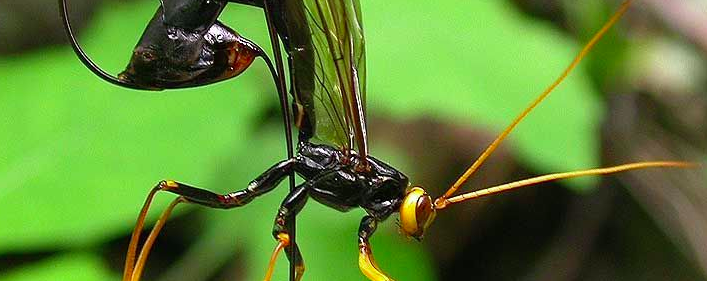
This insect looks like a large, slender wasp . Its head is yellow with a dark stripe between the eyes. The thorax and abdomen are dark, black or black-brown. The dominant color of the long legs is yellow. The four wings, elongated and narrow, are almost black.
The female has an impressive dark brown ovipositor measuring 12 to 15 cm long.
This species resembles two other rhysses found in the same habitat in Quebec. These are Cinnamon Rhysse ( Megarhyssa macrurus ) and Green Rhysse ( M. greenei ). You can recognize blackish rhysis by the brown-black color of its abdomen. In addition, this species has the longest ovipositor.
Life cycle
The blackish rhysis is an ectoparasitoid, that is, it needs a host to complete its life cycle, it is an external parasite (it does not live inside the host) and that it kills its host during its growth.
In Quebec, adults fly from May to September. They live for about 27 days, during which they mate. The female then searches for a host on which to lay eggs. It is often the larva of the tremex ( Tremex columba ). This one lives in the wood, and the female uses her long ovipositor to reach it. The young rhysse feeds on its host during its four larval stages. It then transforms into a pupa, and then emerges externally as an adult. The life cycle lasts about two years.
Geographical distribution
This species is found in southeastern Canada, as well as northeastern and central United States.
Habitat
This insect lives in environments made up of deciduous trees.
Food
The larva of this species derives its nutrients from the body of its host insect, usually the tremex , the larva of which burrows into the wood. Rhysse lays each of its eggs directly on a host larva. A living pantry is sufficient for the development of the rhyssa larvae.
Adults do not feed.
What you need to know
Little is known to scientists about the means of spotting tremex larvae by females. Among the hypotheses stated, it is possible that the olfactory or sound signals emitted by the prey are picked up by the antennae of the females who then manage to locate them precisely. During the laying, the female pierces the wood with her ovipositor to the larva. This action can last an hour which makes the immobile insect very vulnerable to predators.
It is not uncommon to find ovipositors stuck in the wood after an attack by a bird, a small mammal or another insect. Females also die because they fail to remove their ovipositor from the tree after spawning.
Ecological roles
The black rhysse acts as an agent of limitation of the populations of Tremex columba by parasitizing its larvae. It is also used for this purpose in biological control.
Although the tremex mainly digs its tunnels in weakened or dying trees, it can inflict damage by introducing fungi during egg laying which invade the vessels of the wood. For this reason, T. columba is sometimes considered a forest pest.